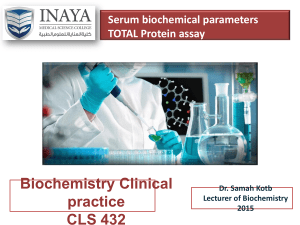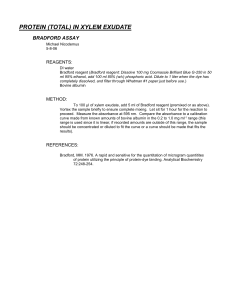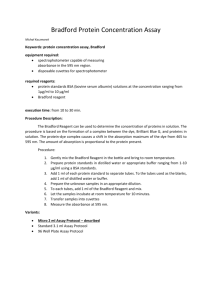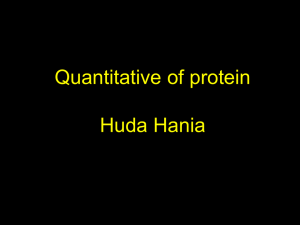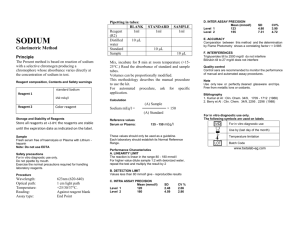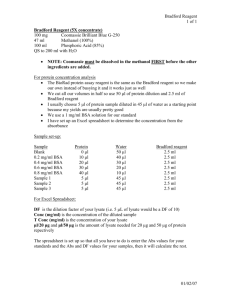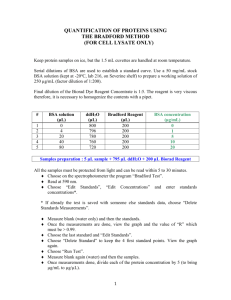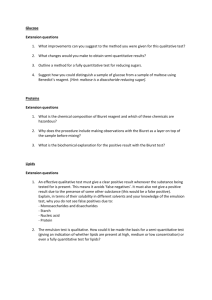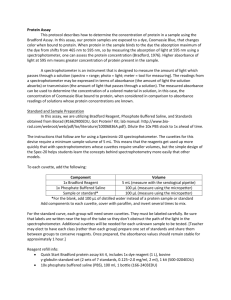Biophotonics Lab: Quantiative Protein Analysis
advertisement
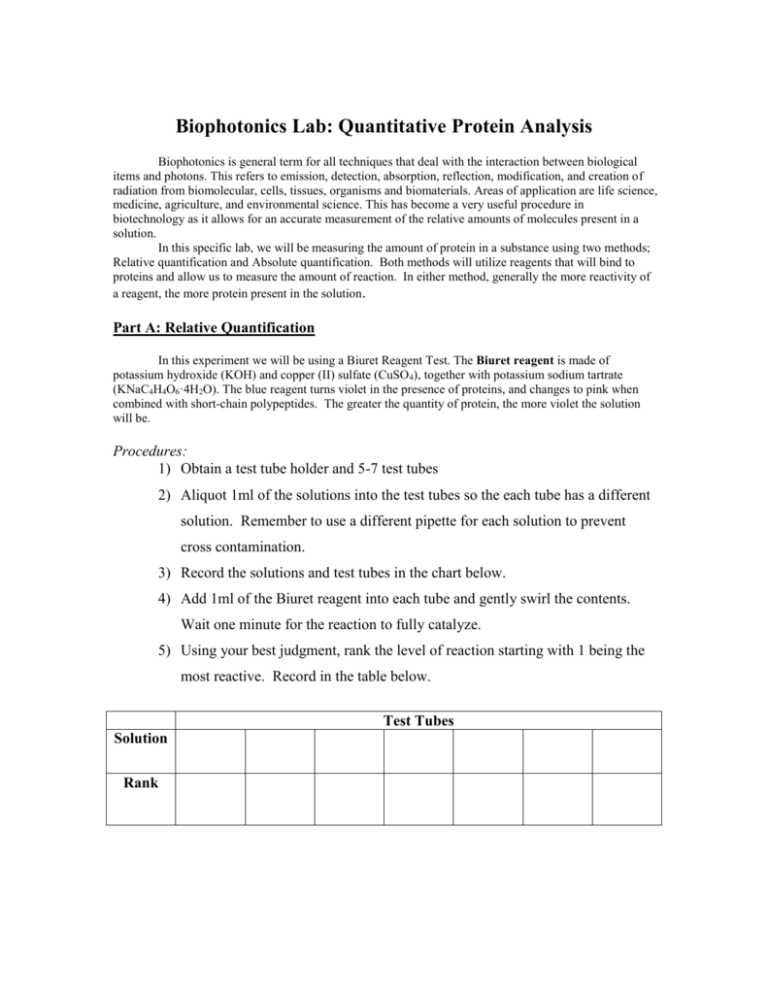
Biophotonics Lab: Quantitative Protein Analysis Biophotonics is general term for all techniques that deal with the interaction between biological items and photons. This refers to emission, detection, absorption, reflection, modification, and creation of radiation from biomolecular, cells, tissues, organisms and biomaterials. Areas of application are life science, medicine, agriculture, and environmental science. This has become a very useful procedure in biotechnology as it allows for an accurate measurement of the relative amounts of molecules present in a solution. In this specific lab, we will be measuring the amount of protein in a substance using two methods; Relative quantification and Absolute quantification. Both methods will utilize reagents that will bind to proteins and allow us to measure the amount of reaction. In either method, generally the more reactivity of a reagent, the more protein present in the solution. Part A: Relative Quantification In this experiment we will be using a Biuret Reagent Test. The Biuret reagent is made of potassium hydroxide (KOH) and copper (II) sulfate (CuSO 4), together with potassium sodium tartrate (KNaC4H4O6·4H2O). The blue reagent turns violet in the presence of proteins, and changes to pink when combined with short-chain polypeptides. The greater the quantity of protein, the more violet the solution will be. Procedures: 1) Obtain a test tube holder and 5-7 test tubes 2) Aliquot 1ml of the solutions into the test tubes so the each tube has a different solution. Remember to use a different pipette for each solution to prevent cross contamination. 3) Record the solutions and test tubes in the chart below. 4) Add 1ml of the Biuret reagent into each tube and gently swirl the contents. Wait one minute for the reaction to fully catalyze. 5) Using your best judgment, rank the level of reaction starting with 1 being the most reactive. Record in the table below. Test Tubes Solution Rank Part B: Absolute Quantification (Beer’s Law) In this experiment we will be performing a Bradford protein assay. The Bradford assay, is a colorimetric protein assay, is based on an absorbance shift in the dye Coomassie. The Coomassie reagent changes in solution and binds to proteins. Binding of the proteins stabilizes the blue form of Coomassie dye, thus the amount of complex present in solution is a measure for the protein concentration by use of an absorbance reading. In order to perform this test we must use a spectrophotometer. A spectrophotometer is a device that measures the amount of light (electromagnetic radiation) a solution (sample) absorbs. We will be using a simple spectrophotometer called a colorimeter to measure the amount of light your samples absorb. A sample put into the path of an electromagnetic ray absorb a quantity of energy from that ray and transmits the remaining energy. The amount of transmitted energy is always less than the amount of incident energy. In short, as light is sent through the sample and absorbed by the Coomassie-protein complex, the remaining light will transmit through to the detector at a fraction of the original amount of light. This is called transmittance, but by measuring this amount, we can infer the amount of absorbance of the sample and therefore the amount of protein in a sample, this is called Beer’s Law. Procedures: 1) Follow the instructions given to calibrate your colorimeter. 2) Obtain enough curvettes for each sample you will be testing, and add 1ml of the Bradford reagent to each. 3) Add 20ul from the dilute solutions (50 parts dH20 to 1 part sample) to separate curvettes. Remember to use the micropipette and change the tips for each solution. 4) Cap the curvettes with the caps and flick the side of the curvettes several times to mix. Let stand for 1-2 minutes. 5) Starting with the known concentration solutions (standards), begin placing each in the colorimeter to obtain an absorbance percentage. Record this information in the table below. 6) Conclude the testing with the unknown samples and record the information in the data table. Curvettes Solution %A g/ml 7) For the unknowns, we do not yet know what the g/ml is, so we must develop a standard curve using our standards. But our concentrations and quantities are so small we need to adjust them so that we can expand the graph. So, from each g/ml value for the standards, multiply that value by 100. This will give us a value per 100ml not 1ml. 8) Plot this information (%A and g/100ml) on the graph below. 9) Draw a best fit line through the points starting at the point f origin (See example). 10) Now, find the g/ml of the unknowns on the best fit line by corresponding the absorbance level (y axis) with the g/ml (x axis). Record the values in the data chart. EXAMPLE: Analysis Questions: 1. Which part of this lab was Qualitative and which was Quantitative? Explain your answer. 2. Compare the results of Part A to Part B. Did your rank in Part A match the data obtain in Part B? Explain this comparison and cite evidence to support. 3. Reflecting back on this lab, which method is the most accurate? In what circumstances would each of these methods be appropriate to determine protein concentrations?
